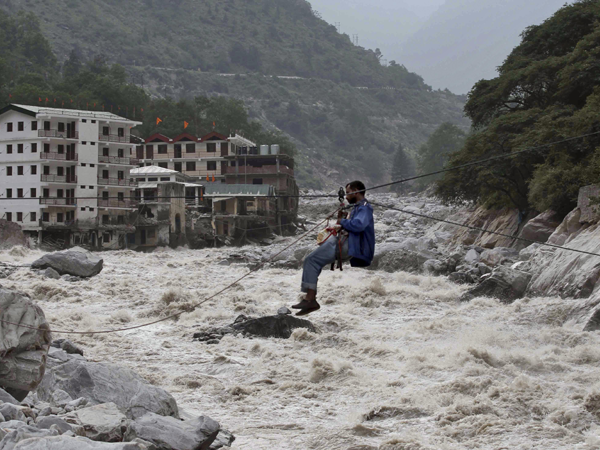
An Indian man crosses over a swollen river with the help of a rope in Govindghat, India, Sunday, June 23, 2013. Rescue operations intensified Sunday in northern India where up to 1,000 people are feared to have died in landslides and flash floods that have also left pilgrims and tourists stranded without food or water for days. AP/RAFIQ MAQBOOL
GOVINDGHAT, India—Rescue operations intensified Sunday in northern India where up to 1,000 people are feared to have died in landslides and flash floods that have also left pilgrims and tourists stranded without food or water for days.
So far 557 bodies have been found after torrential rains struck the Himalayan state of Uttarakhand on June 15, flooding the Ganges river and devastating the region known as the “Land of the Gods” for its revered Hindu shrines.
Some 10,000 people were still stranded in remote areas with the full extent of the loss of life only likely to emerge after flood waters recede and rescue workers reach isolated areas, officials said.
“The death toll could be more than 750—maybe around 1,000,” Uttarakhand chief minister Vijay Bahuguna said in the state capital Dehradun.
A total of 12,000 people were rescued by the ground and air force personnel braving rough weather and inhospitable terrain, an official statement said, as distraught relatives waited for news of their loved ones.
“Rescue and relief operations continued in full swing today (Sunday) despite bad weather in the morning. 12,000 people were rescued and evacuated,” it said.
In Govindghat, a small town on the route to the Sikh holy site of Hemkund, army personnel built temporary bridges by stringing ropes across river banks to help civilians cross safely, an AFP reporter at the scene said.
Rescue officials in Dehradun said 550 people who were left stranded in the remote Jungle Chatti region had been evacuated.
“We have also steered to safety another 2,500 people from Badrinath,” they said.
Raging rivers have swept away houses, buildings and entire villages in the state, which was packed with travellers in what is a peak tourist season.
Dozens of helicopters and thousands of soldiers have been deployed to help those trapped, including many residents whose houses have been damaged.
Around 120 bodies have been recovered from the Kedarnath temple complex and more were feared to be lying in a nearby jungle where tourists took refuge after hotels and other buildings collapsed in the deluge.
Nishi Shrivastava, 30, recounted with horror how she had to virtually “navigate” among dead bodies strewn near the Kedarnath temple site.
‘Bodies everywhere’
“Bodies were lying everywhere. It was worse than a nightmare. I had lost all hope of seeing my family members again,” she told AFP before boarding a bus in Dehradun to go back home to Agra in neighbouring Uttar Pradesh state.
Air relief operations resumed in the areas of Harsil and Dharasu after being suspended on Sunday morning due to rain and overcast conditions, Indian Air Force spokeswoman Priya Joshi told AFP.
For thousands of stranded people, it has been a grim battle of survival against the odds, an army rescue worker who did not want to be named told AFP.
“They have been stuck for more than five days without food or water. Temperatures have been dipping sharply in the night but they do not have any shelter,” he said.
Some survivors complained they had been exploited by locals eager to profit from their misery.
Shri Purushottam, a 50-year-old from Maharashtra state, cried inconsolably as he recalled the moments when his 10-year-old son lay lifeless in his arms.
Dying from hunger and thirst
“He died of sheer hunger and thirst. I kept pleading for help. Some villagers said they could arrange for him to be air-lifted if I gave them 35,000 rupees ($520).
“I agreed but they took my son away and abandoned him later on,” he told AFP.
The disaster relief force meanwhile deployed unmanned drones to locate survivors in remote areas that remained inaccessible.
TV images also showed paratroopers using ropes to descend from military choppers to assist in rescue operations.
Special trains and buses have been pressed into service to bring tourists home while medical and food supplies were being flown to stranded people.
State officials said Sunday nearly 80,000 people had been evacuated so far from the flood-devastated regions.
India’s government has already announced a $170 million relief package for victims and the United States announced Sunday that it would provide $150,000 in aid.
“We are deeply saddened by the tremendous personal loss and the damage” to houses and infrastructure, US ambassador Nancy Powell said as US Secretary of State John Kerry began a visit to New Delhi.
The monsoon, which covers the subcontinent from June to September, usually brings some flooding. But the heavy rains arrived early this year, catching many by surprise and exposing a lack of preparedness.
Floods and landslides from monsoon rains have also struck neighbouring Nepal, leaving at least 39 people dead, according to the government in Kathmandu.—Manan Vatsyayana